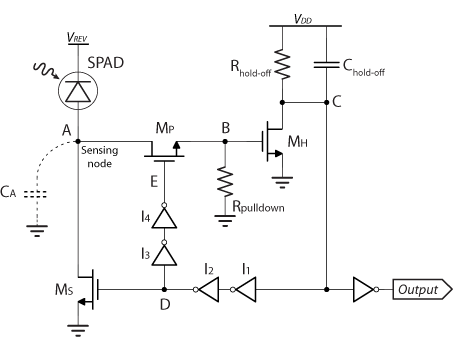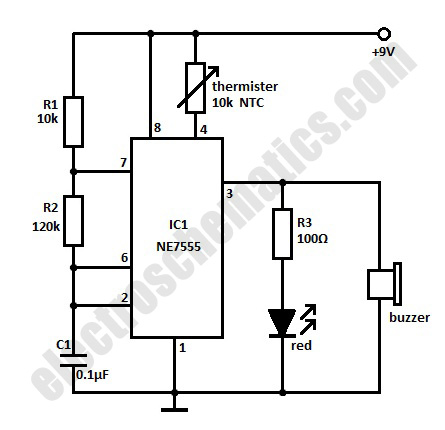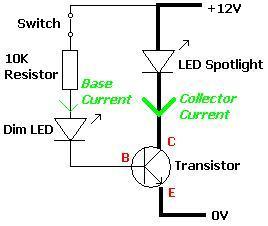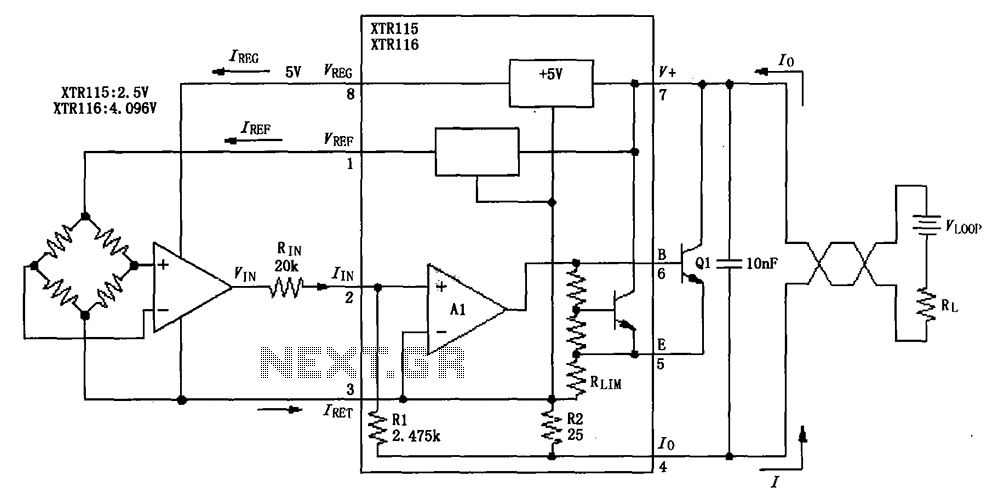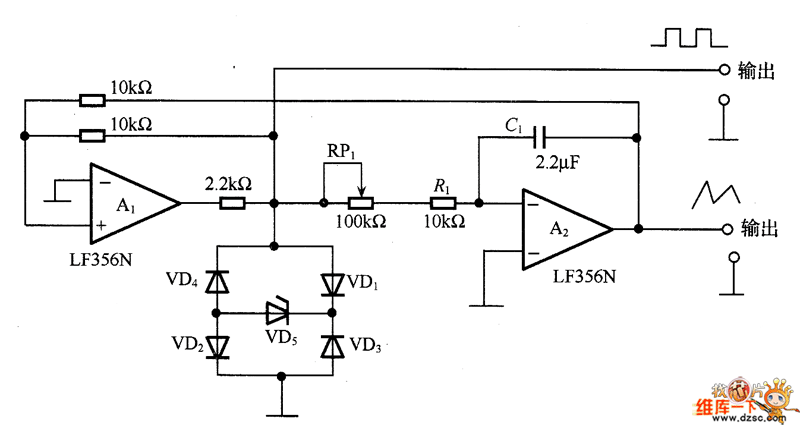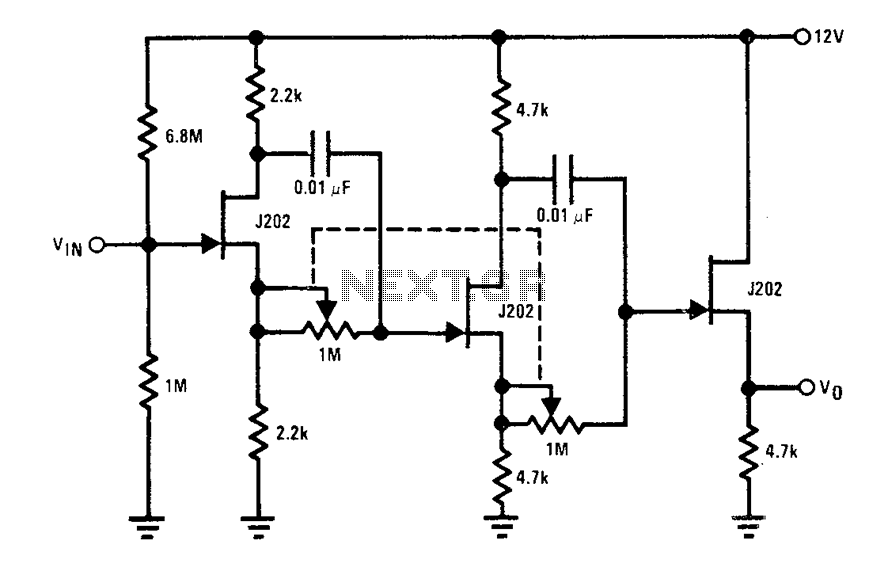
automatic water level circuit

The circuit utilizes the Trigger and Threshold pins (2 and 6) to monitor maximum and minimum voltage levels. Two voltage comparator operational amplifiers within the 555 timer manage the output state, switching it on or off. The Trigger pin (2) is indicated as HIGH, but it is activated (output goes HIGH) when the voltage falls below one-third of the supply voltage. Conversely, the Threshold pin (6) is shown as LOW, resetting (output goes LOW) when the voltage exceeds two-thirds of the supply voltage. The GROUND probe connects to a level slightly below the minimum desired voltage, serving as a common reference. The LOW and HIGH probes are adjusted to the specified levels. Resistors R1 and R2 (1MΩ) connect the Trigger and Threshold pins to the positive supply rail, keeping both pins HIGH. To activate the output of IC1, the Trigger pin must drop below one-third of the supply voltage (4V in a 12V system). While the Trigger pin remains HIGH, the output stays LOW, indicating a phase reversal. When IC1’s output is HIGH, transistor TR1 conducts, pulling the collector of TR2's GATE junction LOW, turning TR2 OFF. Consequently, the pump or relay coil, connected between the positive rail (+12V) and TR2's DRAIN, remains de-energized. When IC1’s output is LOW, TR2’s GATE receives a HIGH signal (+12V) and conducts, activating the pump and filling water. As the water level rises, a water bridge forms between the GROUND probe and the LOW probe (Threshold, pin 6), establishing a low-resistance path relative to the high resistance of R2 (1MΩ), which lowers the voltage at this pin. However, this change is disregarded by IC1 since its output is already LOW (reset mode). Once the water level reaches the HIGH probe, a similar water bridge forms, lowering the trigger voltage below the required threshold (one-third of the supply voltage), triggering IC1 and switching its output HIGH. This action turns on TR1, removes the bias voltage/current from TR2, and stops the pump, completing the filling cycle.
The described circuit employs a 555 timer in a comparator configuration to control a pump or relay based on water level detection. The functionality hinges on the interaction between the Trigger and Threshold pins, which are monitored for voltage levels corresponding to the desired water levels. The use of resistors R1 and R2 ensures that the pins are biased to the supply voltage, allowing for a responsive control mechanism.
In practical applications, the circuit can be utilized in various automated water management systems, such as aquariums, water tanks, or irrigation systems. The design ensures that the pump operates only when necessary, preventing overflow and ensuring efficient water usage. The choice of a 555 timer for this application is advantageous due to its reliability, ease of use, and availability. Additionally, the configuration allows for easy adjustments to the threshold levels by modifying the resistor values, enabling customization based on specific requirements.
Overall, this circuit exemplifies a robust solution for water level detection and control, demonstrating the effective use of operational amplifiers within the 555 timer architecture to achieve desired operational outcomes.Here we are using the Trigger and Threshold pins (2 & 6) to detect the maximum and minimum levels, respectively. The two voltage comparator op-amps inside the 555 control the output, turning it on/off. Looking at the circuit diagram you will notice that the Trigger` pin (2) is marked HIGH probe`, despite being triggered (output goes HIGH) when t
he voltage drops below 1/3 of the supply voltage and, the Threshold` pin (6) is marked LOW probe` while it is reset` (output goes LOW) when the voltage rises above 2/3 of the supply voltage. If this appears to you as being upside-down. One is the GROUND` probe, going to the level a little lower than the minimum desired level. This is the common` (or reference`) probe. The LOW and HIGH probes are set at the desired levels. Resistors R2 and R1 (1M) tie the Trigger` and Threshold` pins (2 & 6) to the positive (+) rail (supply).
In other words, both pins are HIGH. Remember (from above), to make the output of IC1 go HIGH, the trigger pin (2) needs to drop below 1/3 of the supply voltage. (4V with a 12V supply) Since the trigger pin is still HIGH, the output remains LOW. Its purpose is phase reversal. It means that when IC1`s output is HIGH, TR1 conducts and pulls its collector/TR2`s GATE junction LOW, so TR2 is OFF.
Since the pump (or relay coil) is connected between the positive rail (+12V) and TR2`s DRAIN, the pump/relay coil is NOT energized. Now, back to the condition when the IC1`s output is low, TR2`s GATE is HIGH (+12V) and conducting. The pump is operating and water is being filled. As the water level rises, a water bridge` is formed between the GROUND (common) probe and the LOW probe` (Threshold, pin 6) This bridge` constitutes a low resistance, relative to the high resistance of R2 (1M), bringing the voltage at this pin to a low level (at least below 1/3 supply but actual voltage depend on the conductivity of the water).
However, this is IGNORED by IC1 since its output is already LOW (in the reset` mode) When the water level reaches the HIGH probe`, a water bridge` is formed between it and the GROUND probe. Just as with the LOW probe, this bridge` constitutes a low resistance, relative to the high value of R1 (1M), bringing the trigger voltage to below the required level (1/3 supply voltage) and IC1 triggers, its output going HIGH.
Now Tr1 is turned on, the bias voltage/current of TR2 is removed and the pump STOPS. The filling cycle is completed. 🔗 External reference
The described circuit employs a 555 timer in a comparator configuration to control a pump or relay based on water level detection. The functionality hinges on the interaction between the Trigger and Threshold pins, which are monitored for voltage levels corresponding to the desired water levels. The use of resistors R1 and R2 ensures that the pins are biased to the supply voltage, allowing for a responsive control mechanism.
In practical applications, the circuit can be utilized in various automated water management systems, such as aquariums, water tanks, or irrigation systems. The design ensures that the pump operates only when necessary, preventing overflow and ensuring efficient water usage. The choice of a 555 timer for this application is advantageous due to its reliability, ease of use, and availability. Additionally, the configuration allows for easy adjustments to the threshold levels by modifying the resistor values, enabling customization based on specific requirements.
Overall, this circuit exemplifies a robust solution for water level detection and control, demonstrating the effective use of operational amplifiers within the 555 timer architecture to achieve desired operational outcomes.Here we are using the Trigger and Threshold pins (2 & 6) to detect the maximum and minimum levels, respectively. The two voltage comparator op-amps inside the 555 control the output, turning it on/off. Looking at the circuit diagram you will notice that the Trigger` pin (2) is marked HIGH probe`, despite being triggered (output goes HIGH) when t
he voltage drops below 1/3 of the supply voltage and, the Threshold` pin (6) is marked LOW probe` while it is reset` (output goes LOW) when the voltage rises above 2/3 of the supply voltage. If this appears to you as being upside-down. One is the GROUND` probe, going to the level a little lower than the minimum desired level. This is the common` (or reference`) probe. The LOW and HIGH probes are set at the desired levels. Resistors R2 and R1 (1M) tie the Trigger` and Threshold` pins (2 & 6) to the positive (+) rail (supply).
In other words, both pins are HIGH. Remember (from above), to make the output of IC1 go HIGH, the trigger pin (2) needs to drop below 1/3 of the supply voltage. (4V with a 12V supply) Since the trigger pin is still HIGH, the output remains LOW. Its purpose is phase reversal. It means that when IC1`s output is HIGH, TR1 conducts and pulls its collector/TR2`s GATE junction LOW, so TR2 is OFF.
Since the pump (or relay coil) is connected between the positive rail (+12V) and TR2`s DRAIN, the pump/relay coil is NOT energized. Now, back to the condition when the IC1`s output is low, TR2`s GATE is HIGH (+12V) and conducting. The pump is operating and water is being filled. As the water level rises, a water bridge` is formed between the GROUND (common) probe and the LOW probe` (Threshold, pin 6) This bridge` constitutes a low resistance, relative to the high resistance of R2 (1M), bringing the voltage at this pin to a low level (at least below 1/3 supply but actual voltage depend on the conductivity of the water).
However, this is IGNORED by IC1 since its output is already LOW (in the reset` mode) When the water level reaches the HIGH probe`, a water bridge` is formed between it and the GROUND probe. Just as with the LOW probe, this bridge` constitutes a low resistance, relative to the high value of R1 (1M), bringing the trigger voltage to below the required level (1/3 supply voltage) and IC1 triggers, its output going HIGH.
Now Tr1 is turned on, the bias voltage/current of TR2 is removed and the pump STOPS. The filling cycle is completed. 🔗 External reference
